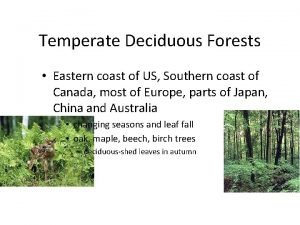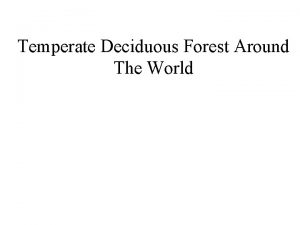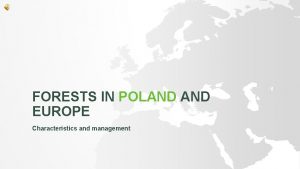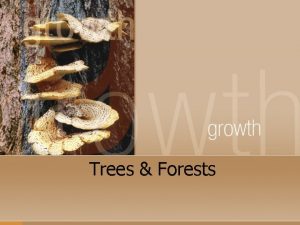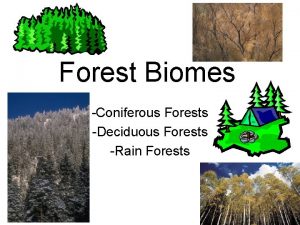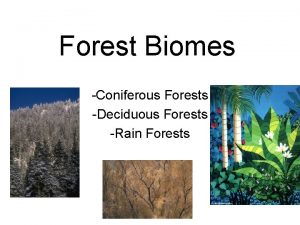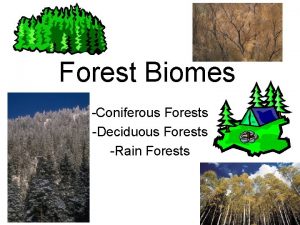FORESTS IN POLAND EUROPE RUSSIAN TAIGA Taiga is










- Slides: 10

FORESTS IN POLAND EUROPE.

RUSSIAN TAIGA • Taiga is the largest zone of the plants in Russia. It covers nearly 60% of the country and on this area it focuses on more than 80% of all the forests of Russia. Taiga can be divided into two sub-zones: the taiga zone proper and the mixed forests. The correct taiga is dominated by coniferous forests.

FRENCH FORESTS • Forests cover 28% of the country. France was primarily covered in deciduous forests which still form large areas of the country focusing on the north and the central part of the country, omitting only the mountain areas and the Mediterranean lands. In the eastern, central and northern part of France grow forests with the participation of beech, oak mixed with hornbeam, maple and fir.

POLAND – BORY TUCHOLSKIE • One of the largest pine forests in Poland. It takes approximately 3 thousand km 2 in the basin of the Brda, the Wda, the Tucholska Plain and the Charzykowska Plain.

SWEDEN FORESTS • Sweden due to a large extent meridian lies on the border of two vegetation zones: mixed forests in the south and taiga in the central and northern parts of the country. The southern part of Sweden is covered with deciduous forests. In the region of Skåne prevail beeches and oaks, and further on the north there is a greater share of coniferous species. Vast areas of Sweden occupy the boreal forests of conifers, or taiga. These forests cover about 2/3 of the country reaching its northern borders. Pines and spruces grow there. Upland mountain regions are covered with birch forests. The upper limit of the forest runs from 900 m in the south to 300 m to the north.

BELARUSSIAN MARSHY FORESTS • Belarus is located on the border of two zones of the mixed and deciduous forests. The natural formation of the plants in Belarus are forests, which today occupy 33% of the country. These are mainly coniferous forests (68% of the forest area) and mixed forests. The most common species is the pine tree, apart from it in the whole country there alders and birches. To the north, up to 25% consists of spruce stand, in the south there is a larger share of hornbeam and oak.

FINNISH TAIGA • Finland's forests form 69% of the country, and about 232 550 km of the National Forests are located mainly in the north of the country, on poor soil peats. In the forests dominated by pine, pine forests occupy 65% of the forest area. Finnish pine and birch branches are thinner than Polish and have more slender stems. Other important species are spruce and birch which form 24% and 9%. There also many poplars and aspens. Other hardwoods are rare. The most valued is spruce, due to its high productivity and thickness.

BEECH FOREST IN GERMANY • Lowland areas are overgrown by monocultures of pine trees and mountain areas are occupied by spruces. Forests cover 29% of the country, which is relatively high if we take into account the high level of economic development, industrialization, urbanization and large population (population density is twice higher than in Poland). In the western part of the lowland Germany preserved forests of birch, oak and moors. The lake districts, the highlands and the lower zones of the mountains are covered with beech forests and mixed forests.

HUNGARIAN BEECH FORESTS • The natural vegetation of Hungary is formed by steppes and oaks occurring in the lowlands and beech forests in the mountains. As the result of the destruction of the forest-steppe and forest steppe spread (called puszta) of fescue and Stipa, these areas are currently used as the arable lands and pastures. Predominant formation of the forests are deciduous forests. In the mountains preserved the fragments of the forests of beech, oak and hornbeam. In the higher parts of the mountains grow mixed forests, where the share of outside deciduous species is pine. Forests cover 21. 5% of the country.

THANK YOU FOR YOUR ATTENTION AUTHORS: MACIEJ KROMER, klasa III gimnazjum SZYMON PIŁAT , klasa III gimnazjum MATEUSZ RZEPKOWSKI , klasa III gimnazjum Zespół Szkół Publicznych w Borzechowie
 Is poland considered eastern europe
Is poland considered eastern europe Deciduous forests are found primarily in africa.
Deciduous forests are found primarily in africa. Coniferous forest weather
Coniferous forest weather Deciduous forests around the world
Deciduous forests around the world Animals in temperate forest biome
Animals in temperate forest biome Apes frq 2014
Apes frq 2014 Healthy forests healthy communities poster contest
Healthy forests healthy communities poster contest Forests
Forests Very dense warm and wet forests
Very dense warm and wet forests Definition for taiga
Definition for taiga Bhadravan vrindavan
Bhadravan vrindavan

